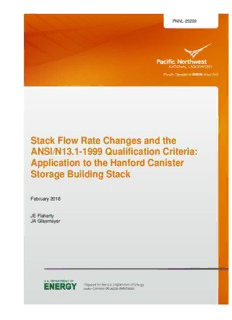
Stack Flow Rate Changes and the ANSI/N13.1-1999 Qualification Criteria PDF
Preview Stack Flow Rate Changes and the ANSI/N13.1-1999 Qualification Criteria
PNNL-25209 Stack Flow Rate Changes and the ANSI/N13.1-1999 Qualification Criteria: Application to the Hanford Canister Storage Building Stack February 2016 JE Flaherty JA Glissmeyer PNNL-25209 Stack Flow Rate Changes and the ANSI/N13.1-1999 Qualification Criteria: Application to the Hanford Canister Storage Building Stack JE Flaherty JA Glissmeyer February 2016 Prepared for the U.S. Department of Energy under Contract DE-AC05-76RL01830 Pacific Northwest National Laboratory Richland, Washington 99352 Summary The Canister Storage Building (CSB), located in the 200-East Area of the Hanford Site, is a 42,000 square foot facility used to store spent nuclear fuel from past activities at the Hanford Site. Because the facility has the potential to emit radionuclides into the environment, its ventilation exhaust stack has been equipped with an air monitoring system. Subpart H of the National Emissions Standards for Hazardous Air Pollutants requires that a sampling probe be located in the exhaust stack in accordance with criteria established by the American National Standards Institute/Health Physics Society Standard N13.1-1999, Sampling and Monitoring Releases of Airborne Radioactive Substances from the Stack and Ducts of Nuclear Facilities.1 The ability of the sampling probe location to meet the monitoring standard was demonstrated with a series of tests conducted on the stack itself in 1998. The tests were performed for the then-current stack flow rates. While the stack flow rates during these tests were primarily between 9000 and 10,000 cubic feet per minute (cfm), the facility has since operated at lower stack flow rates of around 8000 cfm. The purpose of this report is to present qualification test results from comparable stacks used to evaluate the impact of reduced flow rate on the qualification of the CSB stack sampling location. Stack qualification test results from four stacks that are geometrically similar to the CSB stack were examined to evaluate the impact of reduced stack flow rate. The test data show that there is often a small slope to the fit line between the velocity of the test and the test result (percent coefficient of variation or degrees). For the CSB stack, it appears that the velocity could be reduced by 1000 feet per minute (fpm) without significant impact on the uniformity of velocity or gaseous tracer. Particulate tracer uniformity may be affected more significantly, but the uniformity is expected to improve with reduced velocity. In addition, the flow angle is not expected to change appreciably with stack velocities lowered by 1000 fpm. Therefore, for all of the qualification test types, it appears that, relative to the maximum tested flow rate, a 50% reduction in flow rate (or 1000 fpm reduction in velocity) would result in tests results that fall within criteria limits. 1 The standard has been reaffirmed in 2011 and is identical to the 1999 version. The regulations have not been updated, so the 1999 version is still referenced. iii Acknowledgments We acknowledge the efforts of Carmen Arimescu in compiling the test results used in this report and Ernest Antonio in providing a peer review. In addition, project specialist Ginny Collier and project controls professional Melanie Chiaradia provided key support in budget and reporting needs for this work. Susan Ennor and Cary Counts provided editorial support on this report. Funding for this effort was provided through a subcontract with CH2M Hill Plateau Remediation Company. Pacific Northwest National Laboratory is operated for the U.S. Department of Energy by Battelle under Contract DE-AE05-76RL01830. v
Description: